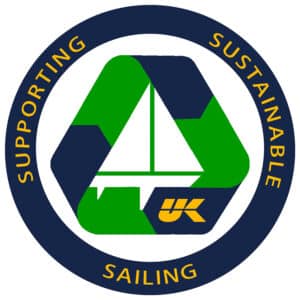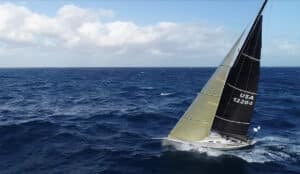Charles Taus, skipper of the J/33 SIRIUS, sent the following email the day after the video of Butch Ulmer’s rules webinar was posted. Charles wrote, watching the video reminded me of a “proper course” question based on a situation from a Thursday night race last year. Can I sail above compass course to next mark if I believe that is the most efficient way to ensure the quickest way to get there — taking current and potential for shifts into consideration? In this race, the wind shifted during the starting sequence turning the first leg into a fetch on port tack. Because of the current and my anticipation that the wind could shift back to the right, I wanted to sail above the compass course to the mark. I’m the green boat in the diagram.”
The answer is of course Green can sail above the compass course to the next mark. On page 9 of the 2021-2024 RACING RULES OF SAILING you’ll find the definition of Proper Course as, “A course a boat would choose in order to sail the course and finish as soon as possible in the absence of the other boats referred to in the rule using the term.”
In this example, if Red was not there, Green would sail higher so that the current would not push her below the mark. Therefore, that is her proper course. The rule makers purposely made the term “proper course” subjective since racers have different ideas on how to sail the course as fast as possible. Green could even justify sailing higher because she saw more wind to windward.
Since Green is the leeward boat, she is the right of way boat and her proper course is the one that counts. Red has to keep clear.
This is true even if Green had created the overlap from astern. Rule 17 “On the Same Tack; Proper Course” states: If a boat clear astern becomes overlapped within two of her hull lengths to leeward of a boat on the same tack, she shall not sail above her proper course while they remain on the same tack and overlapped within that distance…” In this case Green is not sailing above her proper course by sailing higher than the compass course to the next mark.
In Charles’ thank you note for this answer, he wrote, “Next time I will hold my course.” This is one more example of how knowing the rules will help you improve your results.




Rule 17 “On the Same Tack; Proper Course” states: …”
In this case Green is not sailing above her proper course by sailing higher than the compass course to the next mark.
Are there any circumstances when Green would be sailing above her proper course and what would the ruling be if Green were more than two hull lengths to leeward?
Essentially under what circumstances does Rule 17 apply?
Rule 17 “On the Same Tack; Proper Course” states: …”
In this case Green is not sailing above her proper course by sailing higher than the compass course to the next mark.
Are there any circumstances when Green would be sailing above her proper course and what would the ruling be if Green were more than two hull lengths to leeward?
Essentially under what circumstances does Rule 17 apply?
Thank you for the clearification
It is not helping the boat with right of way, that he now knows for sure.
He asked to luff. The boat at luff should know the rules and luff to his ability instead of discussing Also if he did not agree.
If the boat with right of way luffs and the boat above does not luff, the only thing the boat with right of way can do is protest. But he will loose anyhow. He can not make a collision and has to fall to the original course and loose distance or not clear the bouy due to current and expected shifts.
Boats that enter a race and do not know the rules, do not care about a protest.
Please focuss on informing the wrong boats about the rules.
Thank you for the clearification
It is not helping the boat with right of way, that he now knows for sure.
He asked to luff. The boat at luff should know the rules and luff to his ability instead of discussing Also if he did not agree.
If the boat with right of way luffs and the boat above does not luff, the only thing the boat with right of way can do is protest. But he will loose anyhow. He can not make a collision and has to fall to the original course and loose distance or not clear the bouy due to current and expected shifts.
Boats that enter a race and do not know the rules, do not care about a protest.
Please focuss on informing the wrong boats about the rules.